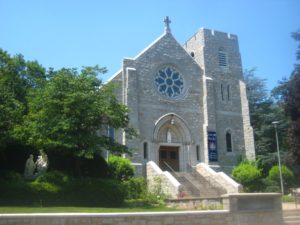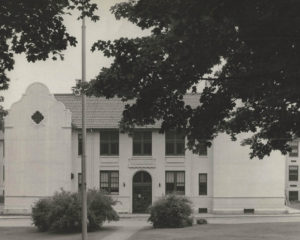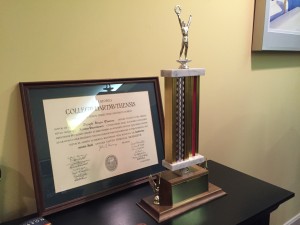I was raised Catholic. And while that sentence sounds fairly passive, my life with the church was not. Although we did not go to Catholic school (my parents were public school teachers) much of my youth revolved around activity at St. Theresa’s Church.

St. Theresa’s was a small, stone church located on a steep hill at the edge of town. It had great wide steps leading up to two large wooden doors. Inside the church were the customary wooden pews facing the altar. Stained glass windows graced the walls as well as fourteen wooden carvings representing the Stations of the Cross. A main altar with two smaller side altars filled the front of the church. Across the back was a choir loft that held the organ.
We were one of many Irish- and Italian-Catholic families living in Briarcliff. You could always tell the Catholic families by the number of children. There were families with twelve and thirteen kids apiece. The Gleasons had six and were considered a small to mid-sized family at St. Theresa’s.
Every Sunday we attended Mass. There were CCD classes on Monday afternoons and confessions on Saturday. But those were the basics; everyone who was Catholic did that.
My brothers and I were also tapped for such things as shoveling the nuns’ driveway and running errands for the priests – usually to and from Weldon’s Deli and the town’s liquor store. (I know, the thought of a kid picking up liquor seems foreign now, but back then, no one thought much about it). Once we had received our Confirmation it also was expected that we become altar boys. This last was considered an honor in my family. And it was.
It was also a challenge. Before Vatican II, priests still faced the altar and the Mass was a ceremony filled with conventions and rites that were a mystery to all but the few of us initiated. The entire Mass was said in Latin so we had to memorize all sixty minutes of it. I remember sitting in a pew with Donny O’Hagan, Craig Hoffman and two of the Luke brothers on Saturday afternoons trying to pronounce the opening phrases of the Mass.
Ad Deum qui Laetúíficat juventútem meam
“Ah day-um kwee la feechi cot. U van too too may–um.”
Although laborious, there was something cool about reciting prayers the same way they had been said for over sixteen hundred years. It took us months to get our parts down and then we had to learn how to serve on the altar. It was like a choreographed play. We had to know where we were needed and for what, when we were supposed to stand, kneel or bow, and all the rules of the altar. “Never pass the tabernacle with out genuflecting, unless you are holding the Bible or the Cross, in which case, you bow.” “When holding the Bible for the priest, keep it at arms length in front of you with your head down. Keep the Bible steady and don’t cover the pages with your fingers.”
My favorite task was to ring the chimes. These were reserved for honoring the Holy Trinity at the start of the Mass and at the Offering of the Eucharist before Communion. (There were three of these chimes and if you hit them in the right order they sounded just like the tones used by NBC Television. But, only the bravest of us ever used them in that order during Mass.)
We dressed in black cassocks (long-sleeved robes that reached our shoes) and a white surplice (a kind of tunic that draped over our shoulders to the waist). There was a dressing room to the right side of the altar where we could change. This was connected to the priest’s vestibule (on the left side) by a narrow tunnel that ran behind the altar. We were expected to prep the altar for Mass (light the candles, fill and place the cruets with the water and wine, and ensure that the readings were marked in the Bible).
Mass was said three times on Sunday and once each day at 5:30 a.m. Weddings and funerals were usually scheduled for Saturdays as were confessions. One altar boy was always assigned to serve at each daily Mass, two at each on Sundays and up to ten on the high holy days of Christmas, Good Friday, and Easter.
The older boys got to do the cooler stuff like carry the cross and lead the procession into the church. They also got to light the incense and clink the chain of the thurible to spew smoke throughout the church. The rest of us mainly brought stuff for the priest to use during mass: the Bible, the water and wine, and water to wash his hands after Communion.
In those days, people knelt at a railing in the front of the church to receive Communion and the priest would move left to right across the altar to dispense the Eucharist. An altar boy would precede him, walking backwards with a plate made of brass. We were told to hold the plate under the chins of the recipients in case someone slipped; the Eucharist was never allowed to hit the floor. Because of this, I had the great pleasure of looking deep into the mouths of every Catholic in the village of Briarcliff for about two years.
There were three priests of note at St. Theresa’s: Monsignor Harrington, Father MacInnerny, and Father Dan Sullivan. Harrington ruled the roost. MacInnerny taught us the Mass. And Sullivan scared the Hell out of us.
Father Dan was a rough and in your face, tough Irish guy from the Bronx, who never lost his street smarts. One of ten kids, and brother to actor Barry Sullivan, he was big, bald, loud and as coarse a man as I had known to that point in my life. I never saw him smoke, but he always had a stogie in one corner of his mouth, which he chewed and ground down to a slimy stub. When he got tired of carrying it around in his mouth, he would hand it to the nearest altar boy, saying, “Here, hold this.”
He had it in for the Irish kids in the parish, because he thought we all shared his underlying demonic nature. I remember once, Frank Scully was in line for confession before me. He went into the booth and closed the curtain. I waited for about thirty seconds, imagining the small sliding door opening for him so he could unburden his soul.
“WHAT?” Father Dan’s shout pierced the quiet of the church. I was so scared I decided to wait another week to confess my sins.
Father Sullivan was a devout man who believed that, through the force of his personality alone, he could move the congregation. This was especially true when it came time to sing the hymns. Unfortunately, he couldn’t carry a tune. He sounded like a baritone Archie Bunker trying to lead the congregation.
“HAH LEY LUUUU YAAA! He would wave his arms to signal the congregation. HA-AH-AH LEY LUUU – YAH!” When no one responded, he would yell at my mother, who was playing the organ in the choir loft. “JAN! Pick it up, up there WILLYA?”
With Vatican II, everything changed. The priests turned to face the congregation. The Mass was said in English. (Yes, we had to relearn the whole thing). The choreography was simplified. At the offering, congregants brought forward the “gifts” of water and wine. At Communion, they stood in a line with their hands cupped to receive the Eucharist. Gone were our little brass trays. There wasn’t much use for altar boys anymore. We mainly served as guides to the congregation, demonstrating when they should stand and sit and kneel.
Strange things began to happen. We had folk Masses where kids with guitars and cymbals rocked the church with more contemporary music. Non-Catholics were invited to join us at Mass (but not Communion). And during one Mass, Father McInnerny gave a Homily (the priest’s lecture on what the Gospel means in today’s world) on divorce and a couple from the congregation spoke up.
“What if we don’t agree?”
Thunderous silence. No one ever talked back to a priest, let alone interrupted Mass.
Father McInnerny had the presence of mind to suggest that anyone interested in further discussion should stay after Mass. About thirty people showed up. I did too. It was just so unprecedented.
I don’t remember stopping my service as an altar boy. It somehow just drifted away from my life. I never got to carry the cross at high Mass or light the incense or clink the chains of the thurible. I simply remember standing in the back of the church with the older boys and men (we were expected to stand when it was crowded). I often was tapped to do the collection – which was still a great honor. But other activities began to crowd into my life: high school, girls, sports. When I graduated, I went off to college and my folks moved away. I returned to St. Theresa’s twice as an adult. Both times for weddings. It seemed impossibly smaller than I remembered it.
Today, I am nowhere near the Catholic my mother raised me to be, but still, all these decades years later, when the priest begins the Mass and offers his prayers, I sometimes find myself whispering the responses in Latin.
“Confiteor Deo, omnipoténti…”

 Their deaths rocked the country. Back in Briarcliff, Doc. Pruitt suspended his lesson plan and opened our 9th grade history class to discussion. I was stunned by the vitriol of the opinions on both sides and I couldn’t believe anyone could see it differently than I did.
Their deaths rocked the country. Back in Briarcliff, Doc. Pruitt suspended his lesson plan and opened our 9th grade history class to discussion. I was stunned by the vitriol of the opinions on both sides and I couldn’t believe anyone could see it differently than I did.

